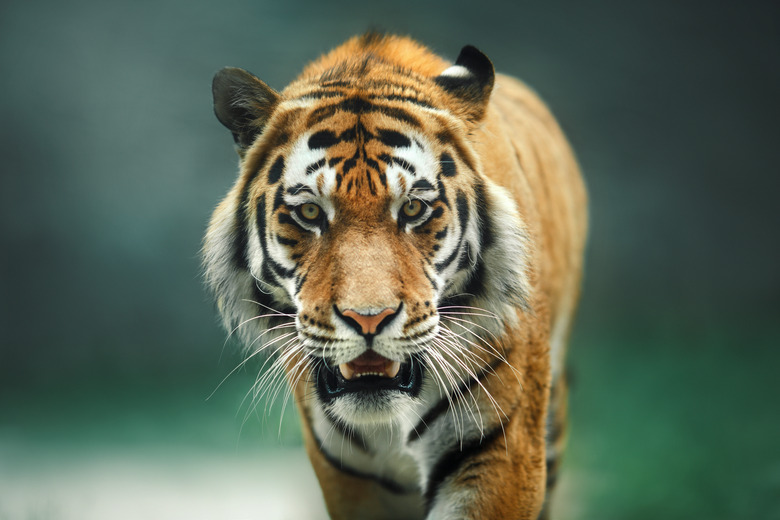The Characteristics & Physical Features Of A Tiger
The tiger is a powerful and colorful species of big cat. They are native to isolated areas of Asia and east Russia. A tiger is solitary in nature, marking out its territory and defending it from other tigers. In order for it to survive and thrive in its own habitat, the tiger has powerful physical features. From razor-sharp teeth to muscular legs, he can catch prey and put up a fight from potential poachers.
Size
Size
An adult tiger can grow as long as 13 feet (4m) and weigh up to 650 pounds (296kgs). The females are usually smaller than the males. The size of a tiger depends on the subspecies and the geographical location of its habitat. The northern subspecies tend to be larger than those in the south. The male adult Bengal tiger found in northern India can weigh up to 480 pounds (218kgs) and measure just less than 11 feet (3.4m). On the other hand, the Sumatran tiger who's native to the Indonesian island of Sumatra can weigh up to 265 pounds (120kgs) and measures 8 feet (2.5m).
Hair
Hair
Tigers have hair all over their body to insulate, protect and camouflage themselves in their habitat. They have two types of hair–guard hair and underfur. The guard hair is long in length and protects the skin. The underfur is shorter and traps air in order to insulate. The color of the hair provides camouflage. There's also a distinct dark striping pattern on its hair and skin. Each tiger has its own individual pattern. They are usually light orange to reddish in color. Some tigers whose both parents have a mutated gene can be white in color with brown stripes.
Tail
Tail
An adult tiger's tail can grow up to 3.3 feet (1m) in length. It also uses its tail to communicate. If he is relaxed, then the tail hangs loosely. If he is feeling aggressive, he'll move the tail quickly from side to side. Alternatively, he'll hold it low and twitch it every once in a while.
Teeth and Jaw
Teeth and Jaw
The tiger uses his powerful jaw to trap and kill prey. Each tiger has approximately 30 razor-sharp teeth in its mouth. Tigers have the largest canines of all big cat species. The canines can grow up to 3 inches (7.6cm) in length and are used to sever the prey's neck. Back teeth are used to shear meat off the prey's bone. The small, front incisors pick small pieces of meat and feathers from prey. The older the tiger, the more worn down the teeth get. In the wild if a tiger's teeth are too worn down and become useless, he could die from starvation.
Legs and Claws
Legs and Claws
Thanks to a muscular pair of legs, the tiger is a fast predator. Five sharp claws on each foot are a vital weapon against any prey or threat to the tiger. The tiger scratches its claws against trees to sharpen them. A sheath covers them when they aren't needed. The claws allow a tiger to climb and grasp things. A male's paws are larger than that of a female tiger.
Eyesight
Eyesight
The tiger has good survival skills with strong eyesight. It has large pupils and lenses, which allows it to see clearly in the daytime. During the nighttime, the tiger can see six times more clearly than humans. This is why it will often hunt for prey at night.
Cite This Article
MLA
Wood, Laura. "The Characteristics & Physical Features Of A Tiger" sciencing.com, https://www.sciencing.com/characteristics-physical-features-tiger-8125281/. 13 March 2018.
APA
Wood, Laura. (2018, March 13). The Characteristics & Physical Features Of A Tiger. sciencing.com. Retrieved from https://www.sciencing.com/characteristics-physical-features-tiger-8125281/
Chicago
Wood, Laura. The Characteristics & Physical Features Of A Tiger last modified March 24, 2022. https://www.sciencing.com/characteristics-physical-features-tiger-8125281/
